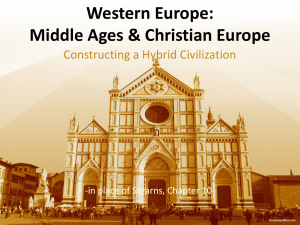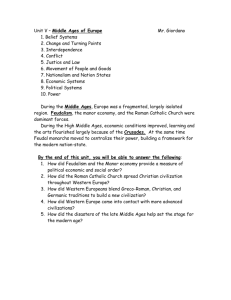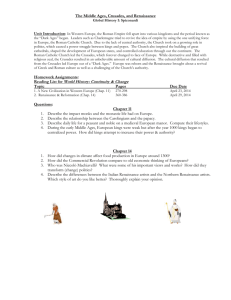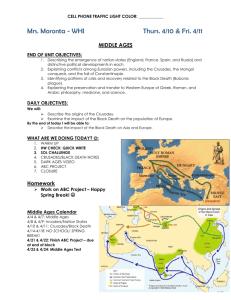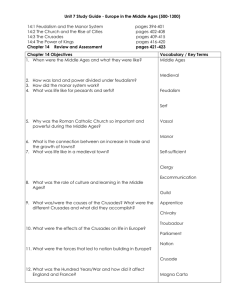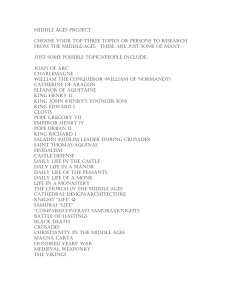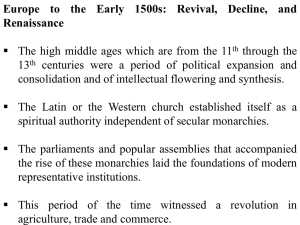High Middle Ages
advertisement
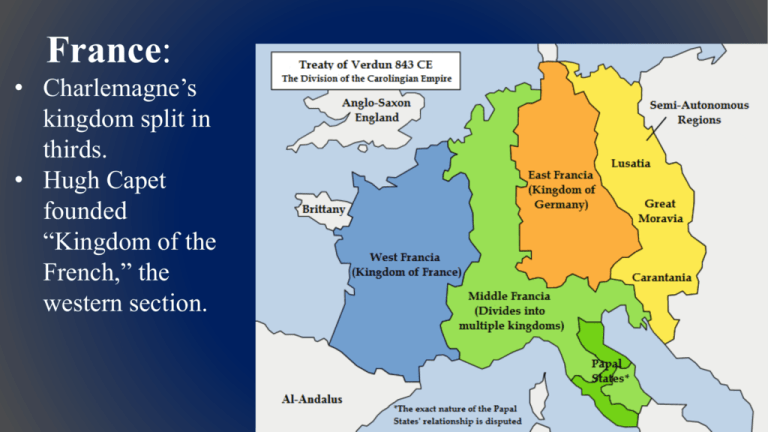
France: • Charlemagne’s kingdom split in thirds. • Hugh Capet founded “Kingdom of the French,” the western section. • Philip IV (r. 1285-1314) created the Estates-General. • Assembly to advise king. • All three classes, or estates, were represented; the clergy, nobility, and commoners. Holy Roman Empire: • Modern day Germany • Founded by Otto I (962). England: • Vikings settled in northern France (Normandy). • Normand king William the Conqueror invaded England (1066). Limits on English king’s power: • The Magna Carta (1215) signed by King John. • Required the king to observe certain rights, like the right to a jury trial before a noble could be imprisoned. • Hundred Years War (13371453); England and France. • England loses all lands in France. Crusades: • An attempt to reclaim the Holy Land of Palestine. • Besides Islam, the Eastern Orthodox Church was also a target of Western European crusaders • • • • Four Crusades only the first was a Christian victory. Captured Jerusalem (1099). Saladin regained the city (1187). Fourth Crusade (1202-1204), Crusaders sacked Constantinople. Long-term impact of the Crusades: • Spain, and Sicily joined Western Christendom. • Egyptian state changed attitude toward its Christian subjects from tolerance to persecution. • Demand for eastern goods opened up global trade. • Global trade led to Black Death. • Plague caused shortage of people weakening feudal • Roughly 5 percent of the population lived in towns. High Middle Ages: • Wealth towns built Gothic style Cathedral. • Lighter, airier, with feature like arches and stained glass. • Latin developed into French, Italian, and Spanish. • Remained formal language of Church. • Pope Gregory stated, in reference to nonChristians in England, “that while they offered the same beasts which they were wont to offer, they should offer them to God, and not to idols; and thus they would no longer be the same sacrifices.” This suggest that non-Christian practices were incorporated into Christian practice. • • • • Roman Catholic Church hierarchy: Pope, supreme bishop of Rome Regional bishops, supervised local priests. Local priest. Lay person, non clergy • Monastic Order: • Monks and nuns lived in communities, or religious orders. • These communities kept learning alive, by copying the classic Greek text into Latin. • Long-distance trade ended in Western Europe after the collapse of the Roman Empire in 476. • It was limited only to Italy. Close to Byzantium. • High Middle Ages Europe’s expansion and growth led to increased long-distance trade. • • • • Manorial System: Fiefs, or estates known as manors. Were economic self-sufficiency. Serfs, not slaves, but were tied to the land. For protection provided by the lord with crops, or labor. Agriculture improvements during the late Middle Ages: • • • • Three-Field System, divide land in three parts and plant two Windmills The heavy plow with wheels Horse collar to yoke teams of horses. • Commerce: • Crusades reconnected Western Europe to the Silk Road and the Indian Ocean trade routes. • Long-distant trade made European innovation possible by borrowing technologies from other civilizations. Knowledge of gunpowder led to creation of cannons. • Marco Polo, Italian merchant, visited the court of Kublai Khan (late thirteenth century). • His writings increased curiosity about Asia. • Stimulated interest in cartography (mapmaking). • • • • • Guilds: Originated in towns. Associations of craftspeople and merchants. Regulated rules for apprenticeships, and exercised quality control. Held economic power in towns. High Middle Ages: • Growth in commerce led to the development of a middle class, also known as burghers. • Only possible as Europe joined in long-distant trade. • Emphasis on economics rather than on purely Christian ideals. • Economic growth during the High Middle Ages affect women in that they practiced trades and sometimes trained female apprentices. • Technological changes in weaving limited women’s opportunities in Western Europe by the fifteenth century. Renaissance: • A revival of interest in classical Greek and Roman literature, art, civic virtue, and culture. • A focus on individuals rather than God. That concludes Medieval Europe Any questions before the quiz on the next slide?
